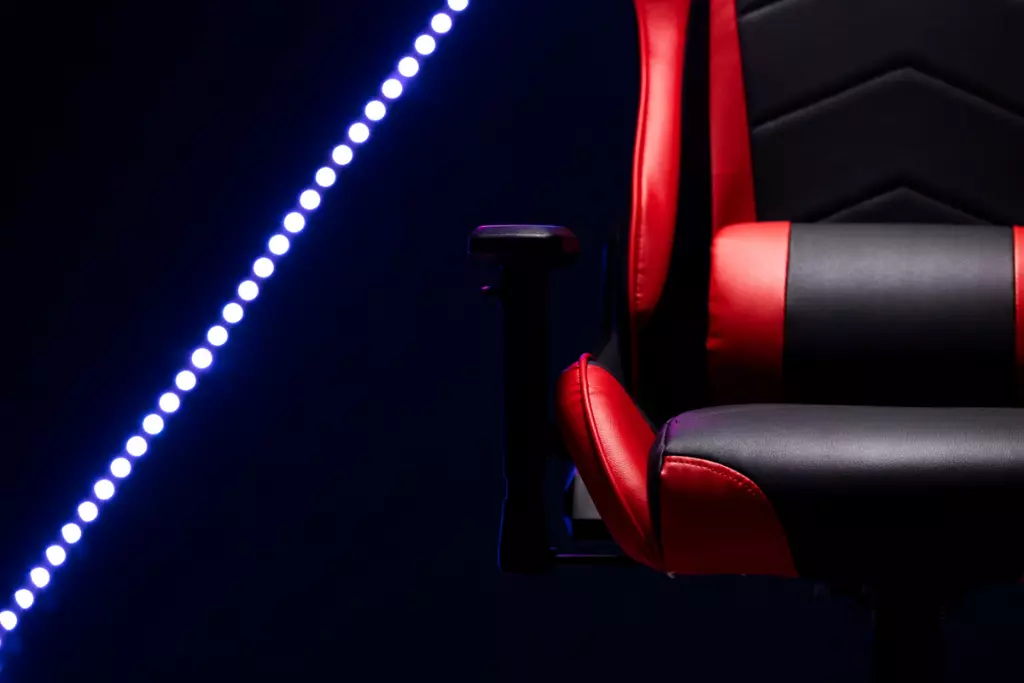Gaming for hours can be very taxing on your body. Sitting in the same position for long periods of time puts strain on your back and shoulders. While a gaming chair is designed to provide comfort and support, there are some things you can do to make your existing chair even more comfortable for those marathon gaming sessions. In this article, we will discuss several effective methods to make your gaming chair more comfortable so you can focus on playing without any back pain or discomfort. After this guide, you will have a complete knowledge of how to make a gaming chair more comfortable.
Customization for Optimal Back Support
One of the primary ways to enhance the comfort of your gaming chair is by adding extra cushioning and lumbar support. The lower back area needs focused support to prevent strains when sitting for extended periods. Here are some simple ways to customize your chair for optimal back support:
Add a Lumbar Pillow or Cushion
One of the simplest and most inexpensive ways is to add a removable lumbar pillow or cushion to the lower back area of your chair. Lumbar supports are designed to maintain the natural inward curve of your lower spine. Look for ergonomic lumbar cushions with contoured shapes that fit perfectly in the curve of your back. Place the cushion in the indent at the lower back of your chair. You can also use regular throw pillows for extra cushioning. Adjust the height until it feels most comfortable. Washable covers let you clean the pillows easily.

Improve the Padding
If your gaming chair seems a bit flat without much cushioning, you can add extra padding to improve the overall comfort. Cut pieces of dense foam to fit the seat and backrest areas. Use upholstery tacks or Velcro strips to securely attach the padding to the existing surfaces. For the seat, aim to add 1-2 inches of thickness. For the backrest, focus on padding the lumbar area more. This extra plushness will make long sessions much easier on your body. Check that the foam doesn’t add too much bulk that could hamper your movement.
Related: Are Gaming Chairs Comfortable? A Comprehensive Guide
Upgrade the Headrest
While adequate lumbar support is important, don’t neglect the head and neck area. Constantly looking down at a screen can create stiffness. A comfortable, well-padded headrest allows you to fully recline and relax those muscles. If your chair lacks a headrest, attach a removable throw pillow or neck roll securely with straps or Velcro. You can also purchase memory foam or contoured gaming headrests online that are designed to fit most chairs. Choose one with smooth edges that don’t put unnecessary pressure on your neck.

How to Improve Seating Comfort
Besides back support, the seat of your gaming chair needs to adequately cushion your hindquarters during marathon sessions. Here are effective seat comfort upgrades:
Use a Seat Cushion
To add more cushioning under your sitting bones, employ a seat cushion. Gel-infused or memory foam cushions are very comfortable, contouring to your shape for pressure relief. Look for ones with ruffled or pleated edges to avoid slippage. Some innovative cushions even have massage nodes to soothe sore muscles. Place the cushion on top of your existing chair seat cover for an instant upgrade.

Customize the Seat Depth and Height
An ill-fitting seat can quickly lead to discomfort. Adjust the seat depth so your lower back doesn’t slump forward and retains its natural inward curve against the backrest. The seat should also be at a height so your feet rest flat on the floor without straining your legs. Many high-end gaming chairs allow custom seat pans, depth, and adjustable height to accommodate different body types. But you can add or remove seat padding under existing chairs to tweak the height and depth for optimal ergonomics.
How to Improve Arm Support
Your arm position while gaming also impacts long-term comfort. Gaming chairs with adjustable armrests provide welcomed flexibility, but even basic chairs can enhance arm support:
Add Wrist Rests
Wrist rests let you relax your forearms fully and avoid slouching shoulders when using keyboards and mice. Place padded wrist cushions on your desktop within easy reach. Gel or memory foam provides gentle cushioning without putting pressure on tender wrist joints. Wrist rests encourage good posture to reduce strain.

Install Ergonomic Armrests
If your chair lacks armrests or they seem uncomfortable, upgrade to aftermarket padding or ergonomic replacements. Look for padded, angle-adjustable armrests sized to your chair that allow arm movement without constraint. Upholstered foam armrests remain gentle on arms and prevent irritation during long sessions. Visit hardware or office supply stores for universal armrest mounts and pads suited for gaming chairs.
Customize the Seating Angle and Tilt
Beyond lumbar support and padding adjustments, being able to vary your seated position is key for preventing pressure points and stiffness:
Upgrade Recline Tilt
Modern gaming chairs often feature adjustable reclines with multiple locked positions, which is great for occasional change in angle. But older basic office chairs may lack this function. You can retrofit them with gas lift or spring cylinder kits available online to add recline. This allows you to shift posture every 30-45 minutes to redistribute pressure and stretch muscles for renewed comfort.
Add a Footrest
While your feet may rest on the floor during regular seated gaming, having a footrest lets you fully recline and relax stressed leg muscles. Mount a padded ottoman platform on casters within easy kicking range of your chair for instant elevation. Lift your feet onto it periodically to relieve pressure from your thighs.
Improve Seat Ergonomics
Try different positions like sitting cross-legged or kneeling on the chair during non-intensive gameplay portions to improve circulation. Some enthusiastic gamers even sit sideways with one foot tucked under for brief stints! Just keep proper back alignment. Being flexible keeps things fresh for extended sessions. It’s also OK to game standing up near your desk using a keyboard/mouse tray. Give your body regular micro-breaks from one position.

Customize Firmness and Breathability
Make sure your gaming chair conforms just right to your body without being too plush or rigid:
Select the Right Density Foam
Most gaming chairs use high-density foam for durability but it may feel too firm for some. You can retrofit seat and back cushions with a top layer of memory or latex foam which nicely contours to your shape without bottoming out. Upholstery foam suppliers have plenty of density options to experiment with for just the right balance of support and plushness.
Improve Seat Ventilation
Leatherette and breathable mesh chairs avoid overheating compared to faux leather. But even vinyl-clad chairs can benefit from drilling ventilation holes every few inches along seat edges or cut vent slots. Cover them with fabric mesh secured by staples. This passively moves air underneath for cool, sweat-free gaming. Consider a small desk fan aimed at your lower back too!
How to Customize for Your Body Type
A universal gaming chair likely won’t feel ideal for every body type. Experiment with customizing dimensions to suit your frame:
Adjust Seat Width and Depth
Wider seats provide ample thigh support for folks carrying more weight but may feel restrictive. Skinnier builds benefit from a slightly narrower seat pan. Similarly, adjust seat depth forward/back until the bend of your knees sits right at the edge for optimal circulation.
Improve Back Support Curves
While lumbar curvatures aim to suit most, tall/short frames may feel back support in different zones. You can add extra padding straps to the upper/mid back areas for customized curve and pressure point targeting. Experiment until it feels completely natural.

Tweak Armrest and Headrest Heights
These accessories shouldn’t force awkward arm or neck angles. Raise/lower mounts as needed so your elbows rest, wrists don’t curl up and your head aligns with your back instead of craning up/down. Proper ergonomics suits individual body maps best.
Final Thoughts
With a few simple cushioning, support and height-adjustment modifications, you can upgrade the comfort of even a basic gaming chair to suit marathon gameplay sessions. Pay attention to back, seat, arm and leg positioning ergonomics tailored to your body type. Incorporate regular postural changes, breathing exercises and short active breaks to promote circulation. A little creative budget-friendly tweaking can go a long way toward preventing gaming injuries and allowing you to enjoy comfort over the long run.
Frequently Asked Questions (FAQs)
Here are some frequently asked questions (FAQs) about making a gaming chair more comfortable, with answers written in simple and friendly language:
Q: What type of cushion should I use for lumbar support?
A good lumbar cushion should be contoured to fit the natural curve of your lower back. Look for cushions of firm yet padded materials like molded or memory foam. This allows the cushion to maintain its shape while still cushioning your back comfortably. Gel cushions can also feel nice and cool on your back during long gaming sessions. Avoid too-soft cushions that will flatten out and not provide proper support.
Q: How thick should additional seat cushioning be?
You generally want around 1-2 inches of extra cushioning on the seat of your gaming chair. Thicker than that and it may start feeling too plush or even cause you to sink down too low. Too thin and it won’t make much difference in comfort levels. Start with 1-inch cushions and stack a second one if needed. The cushioning should feel like it’s filling out any gaps but not making the seat feel overly stuffed.
Q: Will adding too many cushions make my chair unsteady?
It’s possible that adding a lot of thick cushions could affect the stability of some gaming chair designs. Chairs with larger, padded seats generally have a lower center of gravity and won’t be as affected. If you find your chair starts feeling wobbly, you may need to remove the thickest cushions. Another option is to use a mix of firm and soft cushions – a memory foam seat cushion topped with a thinner padding, for example. As long as the bulk of the padding remains low on the chair, it usually won’t cause issues. Start with a moderate amount and remove layers as needed.
Q: Can I wash gaming chair cushions and covers?
Most removable gaming chair cushions and covers can be spot-cleaned or gently washed. Check the care tag for specific instructions, but in general, a mild detergent in cool or warm water on a gentle cycle should be safe for most breathable fabrics. Air dry completely to prevent mildew. For memory foam pieces, spot clean with a damp cloth only. Vinyl or leather portions may require a gentle leather cleaner – don’t submerge. Proper care helps cushions last longer between deeper professional cleaning or replacement.
Q: Will adding cushions void the chair’s warranty?
Most warranty policies won’t consider additional cushioning or padding as modifications that void coverage, as long as it doesn’t structurally compromise the chair. Manufacturers want customers to be comfortable. Just be sure any additions don’t place undue stress on seat supports or mechanics over time. Minor cushioning for comfort purposes won’t impact stability. But don’t attempt major rebuilds or permanent alterations without checking manufacturer policies first. Reasonable modifications for comfort or adjustability are usually fine.







